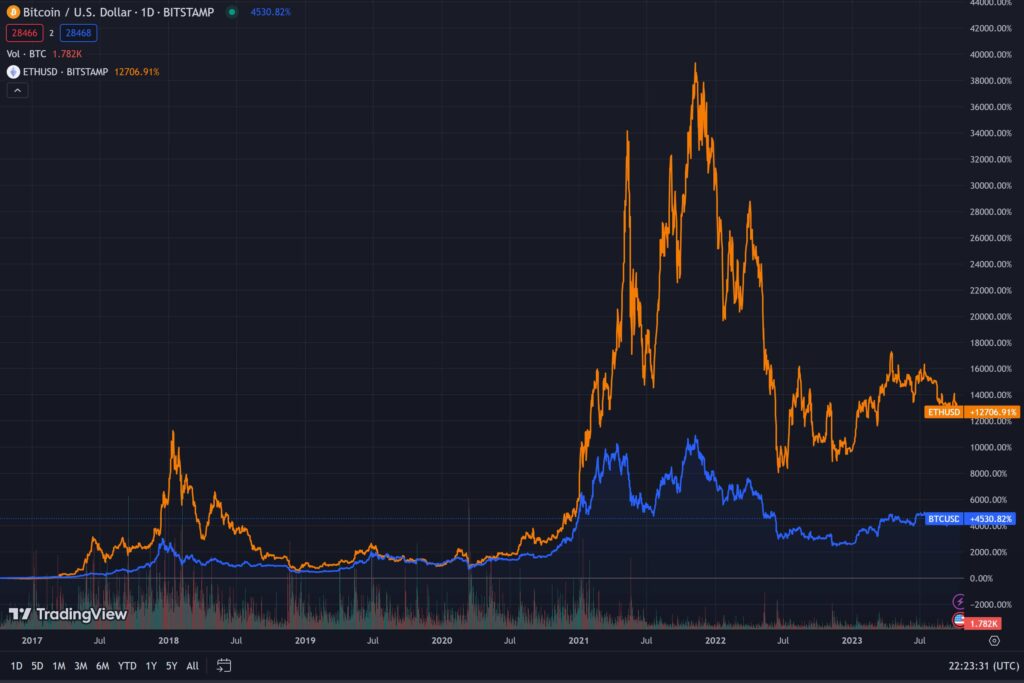In the vast cosmos of digital assets, the shining stars known as Bitcoin and Ethereum often catch the curious eyes of both fledgling and seasoned investors. Their luminescence in the cryptocurrency space is not just a happenstance, but a testament to the unique values and functions they bring to the digital table. However, despite their common dwelling in the cryptocurrency realm, Bitcoin and Ethereum serve distinct purposes, each boasting a different set of features and potential benefits for their holders. As we journey through the intricate pathways of these cryptocurrency titans, we’ll uncover the core differences that set them apart, thereby aiding you in making an informed decision on which digital asset aligns with your financial voyage.
Key Takeaways
Aspect Bitcoin Ethereum Founded 2009 2013 Primary Use Digital Currency Smart Contract Platform Consensus Mechanism Proof of Work (PoW) Transitioned to Proof of Stake (PoS) Block Time 10 minutes 12-14 seconds Supply Cap 21 million No hard cap Market Dominance Higher Lower Development Community Focused on security and stability Broader, focused on application development
This table encapsulates the essence of the differences between Bitcoin and Ethereum, shedding light on their individual characteristics and market positions. As we delve deeper into the subsequent sections, we’ll unravel the intricacies of these differences, thereby equipping you with the knowledge to navigate the cryptocurrency market with a discerning eye.
Historical Background
Birth and Evolution
Bitcoin
Bitcoin, conceived in 2009, is the brainchild of an anonymous entity known as Satoshi Nakamoto. It emerged as a revolutionary digital currency, providing a decentralized means of value exchange, free from governmental or institutional control. Here are some pivotal moments in Bitcoin’s timeline:
- 2009: Bitcoin network comes to life.
- 2013: Bitcoin reaches $1,000 valuation milestone.
- 2017: Bitcoin hits the monumental $20,000 mark.
- 2021: Bitcoin surpasses $60,000, capturing mainstream attention.
Ethereum
Ethereum, on the other hand, was birthed in 2015 by a visionary named Vitalik Buterin, aiming to expand the blockchain horizon beyond just monetary transactions. Here are some key milestones:
- 2015: Ethereum network is launched.
- 2017: Introduction of ERC-20 token standard, fueling the ICO boom.
- 2020: Ethereum 2.0 Phase 0 is launched, marking the beginning of its transition to Proof of Stake.
Comparative Analysis
Comparing the historical trajectories of Bitcoin and Ethereum reveals their distinct focuses and the evolutionary paths they have traversed.
| Year | Bitcoin | Ethereum |
| 2009 | Network Inception | |
| 2015 | Network Inception | |
| 2017 | Hits $20,000 | ERC-20 Standard Introduced |
| 2020 | Ethereum 2.0 Phase 0 Launched | |
| 2022 | Hits $68,000 | Ethereum 2.0 Phase 1 Launched |

This historical backdrop sets the stage for understanding the technical and functional divergences between Bitcoin and Ethereum, which we will explore in the following section.
Technical Divergence
Consensus Mechanisms
Bitcoin
Bitcoin operates on a Proof of Work (PoW) consensus mechanism which requires miners to solve complex mathematical problems to validate transactions and create new blocks.
Ethereum
Ethereum, initially operating on PoW like Bitcoin, is transitioning to a Proof of Stake (PoS) mechanism through its Ethereum 2.0 upgrade, which is considered to be more energy-efficient.
Block Time and Supply Cap
| Aspect | Bitcoin | Ethereum |
| Block Time | 10 minutes | 12-14 seconds |
| Supply Cap | 21 million | No hard cap |
The block time in Ethereum’s network is significantly shorter, allowing for faster transaction validation. Unlike Bitcoin, Ethereum has no hard cap on the supply of its native cryptocurrency, Ether, which leads to different economic implications.
These technical disparities contribute to the broader differences in use case scenarios and market dynamics between Bitcoin and Ethereum, further explored in the next section.
Purpose and Use Cases
Digital Currency Versus Smart Contract Platform
Bitcoin
- Primary Use: Serves as a digital currency for peer-to-peer transactions.
- Market Perception: Often seen as “digital gold” due to its store of value characteristics.
Ethereum
- Primary Use: Facilitates smart contracts and decentralized applications (dApps).
- Market Adaptability: Provides a platform for DeFi projects which is a burgeoning field in the crypto space.
These fundamental differences underscore the diverse applications and potential investment considerations between Bitcoin and Ethereum, which we will delve into in the subsequent sections.
Market Dominance and Investment Perspective
Market Capitalization and Investor Interest
Bitcoin
- Market Dominance: Maintains a higher market cap, attracting long-term investors.
- Investor Perception: Viewed as a store of value akin to gold.
Ethereum
- Market Adaptability: Rapidly growing sector due to its smart contract functionality.
- Investor Perception: Seen as a gateway to decentralized finance (DeFi) and other blockchain-based applications.
The market dynamics and investor perspectives further elucidate the differing positions of Bitcoin and Ethereum in the cryptocurrency realm, each offering a unique proposition to the market.
Development Community and Ecosystem
Innovation and Support
Bitcoin
- Community Focus: Primarily on enhancing security and stability.
- Ecosystem: Limited to financial applications.
Ethereum
- Community Focus: Broad, with emphasis on creating diverse applications.
- Ecosystem: Expansive, including DeFi, NFTs, and more.
The contrasting focus of the development communities and the resultant ecosystems further accentuates the distinct positions Bitcoin and Ethereum occupy in the blockchain space.
Future Prospects
Upcoming Upgrades and Market Scenarios
Bitcoin
- Scalability Solutions: Implementing solutions like the Lightning Network to enhance transaction speed and scalability.
- Market Prediction: Continued growth as a store of value.
Ethereum
- Ethereum 2.0: Transition to a more scalable and energy-efficient Proof of Stake (PoS) mechanism.
- Market Prediction: Broader adoption due to its smart contract platform and DeFi capabilities.
These imminent advancements signal exciting future scenarios for both Bitcoin and Ethereum, potentially reshaping the cryptocurrency landscape.
Unveiling the Crypto Titans: Final Thoughts
The voyage through the distinct realms of Bitcoin and Ethereum unveils a spectrum of possibilities, each with its unique allure and potential hurdles. While Bitcoin remains a robust store of value, Ethereum’s versatile platform heralds a new era of decentralized applications. As the crypto landscape continues to evolve, the knowledge of these distinctions is a potent tool for any discerning investor, guiding them through the myriad choices in the digital asset universe.
Frequently Asked Questions
| Question | Answer |
| What is the main difference between Bitcoin and Ethereum? | Bitcoin is a digital currency, while Ethereum is a smart contract platform. |
| Which is more valuable, Bitcoin or Ethereum? | As of now, Bitcoin has a higher market value compared to Ethereum. |
| Can Ethereum overtake Bitcoin in market cap? | It’s speculative, and depends on market dynamics and future developments. |
| Which has a larger community, Bitcoin or Ethereum? | Both have large communities, but Ethereum has a broader development focus. |
| How do Bitcoin and Ethereum’s consensus mechanisms differ? | Bitcoin uses Proof of Work, while Ethereum has transitioned to Proof of Stake. |




